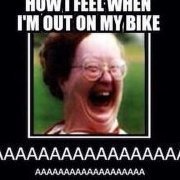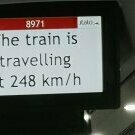
lorenzo
Site Supporter-
Posts
285 -
Joined
About lorenzo
 |
Contact Information
-
Yes, points open/points closed, it wouldn't work if it didn't. I have to make a few assumptions.... Are you sure you know how a magneto works ? Where are you showing this continuity ? And are you using an ohmeter ?
-
Here's what I think : It isn't a Sherpa tank, but late Alpina.
-
I have to ask, Is there such a person ? I had a Cavalier when it was a relatively new bike ; parts were not easily obtainable back then, and the situation has deteriorated steadily since. It would probably help you to bear in mind that much of the bike is an assemblage of proprietary parts : Engine (Mexican) Minarelli / (Italian) Dellorto carburettor, CEV magneto, Grimeca hubs / (British) MP forks, Dunlop or Jones rims, Girling shocks, etc. and so main sticking point would be engine parts, I would think. My bike, back in the day : I wish you the very best of luck with your machine.
-
mattbradders - I have two matching numbers Bultacos (earlier) mod. 199. There is no dash / horizontal stroke after the serial nos. of frame and engine stampings on either machine ; the dash after the frame serial no. in the steering head pic of your bike convinces me that there is (or at least there was intended to be) an 'A' following. HTH
-
+ 1 re feetupfun's comments. However.............the info. I have is that 199A series started at serial #19905965 - if this is correct then it should be a 199A. Is there an 'A' stamped on the engine ?
-
Colby - John Healy is a recognised authority in setting up and using Amal Carbs. Here's what he had to say to a user with the same problem as yours :- "First you must establish that the float level is proper. The tickler travel is determined by how far the roll pin is pressed into the button. The travel is adjustable. To increase the travel pull the pin out of the button a tad. This is easily done with a diagonal cutting pliers (not electricians pliers!). Push the button to exend the pin out of the body as far as it will go. Grasp the pin firmly (it is hardened steel) at the point it is just exiting the body with the diagonal pliers and lever the pin out. Be careful that you don't mark the float bowl gasket face. You should be able to get another 1/8" or so of travel. This should solve your problem. " (I'll add that I haven't actually tried it myself as none of my carbs have ever displayed the problem.) HTH
-
In the UK/NI a 1975 Sherpa supplied as an observed trials machine would not have had lights fitted. Brochures of the period featured machines as supplied to other than the UK/NI market. The machine may or may not have had a lighting coil as supplied, but this is irrelevant to the stoplamp question as the stoplamp was powered by the ignition coil on machines supplied to other markets with full lighting equipment. To quote from the UK M.O.T Testers Manual (excerpt from the relevant section) : - Section 4.3.3 states stop lamps are not needed on motorcycles that : do not have front and rear position lamps. HTH
-
Correct Amal settings for a Trials BSA C15 engine.
lorenzo replied to chappo's topic in Pre-65 Bikes
Chappo - Original carb. fitment would have been a 7/8" bore Monobloc type 375/34 or 375/51 ; this specn. number would be stamped on the mounting flange. As it's extremely unlikely that a Trials bike of maybe 60 years old would have retained its original carb., I wonder what the bike in question has ? -
Max - Ratchet appears to be correctly assembled, although I can't see ratchet spring. To ensure correct return spring tension, the kickstart shaft also needs to be in the correct position in rerlation to the ratchet. Viewed from the left side (outside the crankcase) the chamfered hole for the spring should face forward i.e. at 9 o'clock when the ratchet is fully disengaged against its stop. woody's earlier response gives an excellent overview of what to look for. While your engine is apart, now would be a good time to attend to the crack in the crankcase above the ratchet ......?
-
I would challenge the idea that it's "better" ; right side brake would operate by cable - definitely not better in terms of feel or effectiveness. Modification : anything is possible with the necessary skills and financial wherewithall, but why would you even bother ? It's an old bike ; just accept it and enjoy it for what it is. Did you struggle with left foot brake / right foot gearchange, and did you consider changing over control sides when you last owned it ? Why not retrain your brain and feet to operate the bike as it is - definitely the more practical (and cheaper) option !
-
Loads of parts still available, but a word of warning : they ain't cheap. Get ready to load the money pistol.........
-
"J" identifies it as 325/340 cc (nominally 350, with 60mm. stroke) "M" is simply "motor" / engine (as opposed to "B" bastidor / frame no.) "173" .... I know nothing.
-
As stated by Pedronicman above : black to points & condenser, green to earth. Get rid of the mains flex. - it's just confusing the issue.....
-
New stanchions the way to go, as others have said. What many users don't appreciate is that the unplated insides of the stanchions are also susceptible to rust.
-
Welcome to the forum, Morten. Forks are Betor, and all the parts look correct and in the correct order. Good luck with your new bike.








